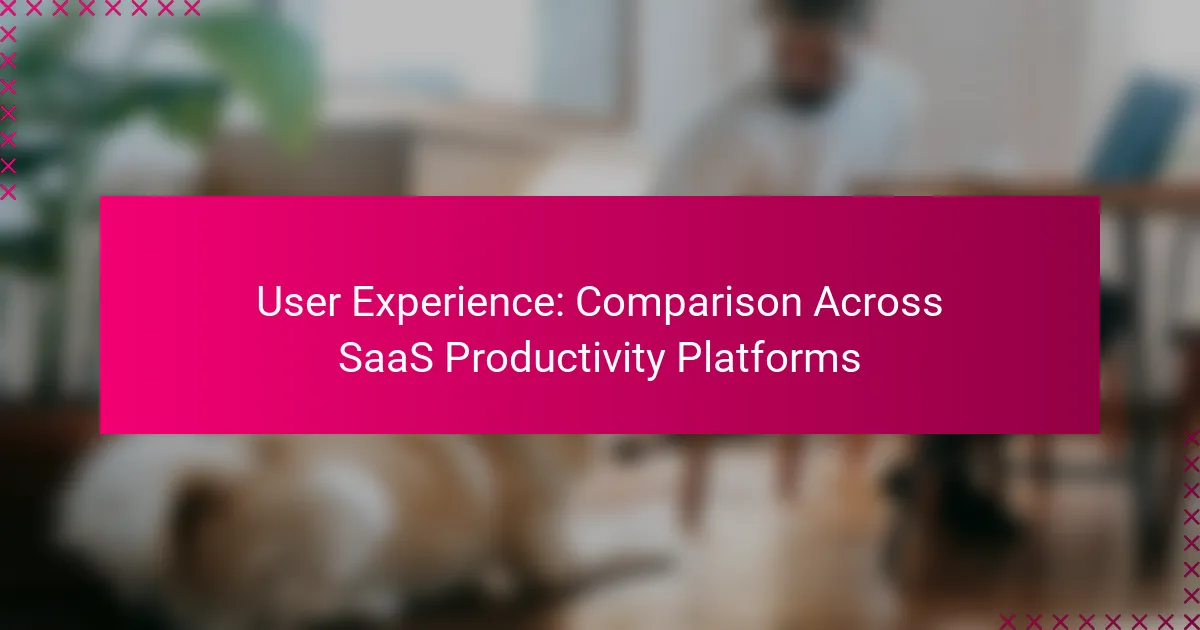In the competitive landscape of SaaS productivity platforms, user experience plays a crucial role in determining which tool best aligns with team needs. Platforms such as Notion, Trello, Asana, Monday.com, and ClickUp each offer distinct features and interfaces, catering to diverse workflows and collaboration styles. By examining key metrics like usability, performance, and user satisfaction, organizations can make informed choices that enhance productivity and streamline project management.

Which SaaS productivity platforms offer the best user experience in the UK?
In the UK, platforms like Notion, Trello, Asana, Monday.com, and ClickUp stand out for their user experience. Each offers unique features and interfaces that cater to different productivity needs, making them suitable for various teams and projects.
Notion
Notion provides a highly customizable workspace that combines notes, tasks, databases, and wikis. Its flexibility allows users to create tailored workflows, but this can lead to a steeper learning curve for newcomers.
To maximize Notion’s potential, start with pre-built templates that align with your team’s needs. Regularly review and adjust your setup to enhance efficiency and collaboration.
Trello
Trello uses a card-based system that is intuitive and visually appealing, making it easy to track tasks and projects. Users can drag and drop cards between lists, which simplifies project management.
For effective use, ensure that your team consistently updates card statuses and utilizes labels for better organization. Avoid overcrowding boards to maintain clarity and focus.
Asana
Asana offers a structured approach to project management with features like task assignments, due dates, and progress tracking. Its user-friendly interface helps teams stay organized and accountable.
To get the most out of Asana, leverage its timeline and calendar views for better planning. Regularly hold check-ins to discuss progress and adjust tasks as needed.
Monday.com
Monday.com provides a visually rich platform with customizable boards that can adapt to various workflows. Its automation features help reduce repetitive tasks, enhancing productivity.
When using Monday.com, take advantage of its integration capabilities with other tools. Regularly review your boards to ensure they reflect current priorities and workflows.
ClickUp
ClickUp is known for its all-in-one approach, combining tasks, docs, goals, and chat in one platform. This versatility can be beneficial, but it may overwhelm users who prefer simplicity.
To effectively use ClickUp, start with basic features and gradually explore advanced options like time tracking and goal setting. Keep your workspace organized to avoid confusion and enhance collaboration.

How do user experiences compare across these platforms?
User experiences across SaaS productivity platforms vary significantly based on interface design, customization options, collaboration features, and mobile accessibility. Understanding these differences can help users choose the platform that best fits their workflow and team dynamics.
Interface design
The interface design of a SaaS platform greatly influences user experience. A clean, intuitive layout can enhance productivity by reducing the learning curve, while cluttered designs may hinder usability. For instance, platforms like Asana and Trello offer visually appealing dashboards that prioritize task management, making it easier for users to navigate.
When evaluating interface design, consider how easily you can access key features and whether the layout aligns with your team’s workflow. Look for platforms that offer customizable views to suit different project needs.
Customization options
Customization options allow users to tailor the platform to their specific requirements, enhancing overall satisfaction. Some platforms offer extensive customization, such as creating custom fields and workflows, while others provide limited flexibility. For example, Notion allows users to create personalized databases, whereas simpler tools may have fixed templates.
When assessing customization, think about your team’s unique processes. Opt for platforms that offer enough flexibility to adapt to your needs without overwhelming users with complexity.
Collaboration features
Collaboration features are essential for teams working together on projects. Effective platforms provide real-time editing, commenting, and task assignment capabilities. Tools like Slack and Microsoft Teams excel in fostering communication, while project management tools like ClickUp integrate collaboration directly into task workflows.
Evaluate how collaboration features align with your team’s communication style. Look for platforms that support integrations with other tools your team already uses to streamline workflows.
Mobile accessibility
Mobile accessibility is crucial for teams that need to stay connected on the go. Many SaaS platforms offer mobile apps, but the quality and functionality can vary. Some platforms, like Google Workspace, provide robust mobile experiences, while others may have limited features on mobile devices.
Consider how often your team needs to access the platform from mobile devices. Choose a solution that offers a seamless experience across devices, ensuring that essential features are available regardless of location.

What are the key user experience metrics to consider?
Key user experience metrics for SaaS productivity platforms include usability, performance speed, user satisfaction ratings, and the availability of support and resources. These metrics help evaluate how effectively users can navigate and utilize the platform, impacting overall productivity and satisfaction.
Usability
Usability refers to how easily users can interact with a platform to achieve their goals. This includes intuitive navigation, clear layout, and the accessibility of features. A platform with high usability typically requires minimal training and allows users to complete tasks efficiently.
To assess usability, consider conducting user testing sessions or surveys that focus on ease of use. Common pitfalls include overly complex interfaces and hidden features that can frustrate users. Aim for a design that prioritizes user needs and minimizes cognitive load.
Performance speed
Performance speed measures how quickly a platform responds to user actions, which is crucial for maintaining productivity. Users expect rapid loading times and quick responses to commands, ideally within low tens of milliseconds for interactions. Delays can lead to frustration and decreased engagement.
To enhance performance speed, optimize backend processes and minimize the use of heavy graphics or scripts. Regularly monitor performance metrics and aim for consistent response times across different devices and network conditions to ensure a smooth user experience.
User satisfaction ratings
User satisfaction ratings provide insight into how users feel about the platform. These ratings can be gathered through surveys, feedback forms, or third-party review sites. High satisfaction ratings often correlate with user retention and loyalty.
When evaluating satisfaction, consider both quantitative ratings and qualitative feedback. Look for trends in user comments to identify strengths and areas for improvement. Platforms with ratings above 80% are generally viewed favorably, while those below may require significant enhancements.
Support and resources
Support and resources encompass the help available to users, including documentation, tutorials, and customer service. Effective support can significantly enhance user experience by providing timely assistance and resources for troubleshooting.
Evaluate the quality and accessibility of support options, such as live chat, email, or phone support. A comprehensive knowledge base and user community can also empower users to find solutions independently. Ensure that support is responsive, with clear channels for users to seek help when needed.

What factors influence user experience in SaaS platforms?
User experience in SaaS platforms is primarily influenced by integration capabilities, pricing models, and onboarding processes. Each of these factors plays a crucial role in determining how effectively users can leverage the software for their productivity needs.
Integration capabilities
Integration capabilities refer to how well a SaaS platform connects with other tools and services. A platform that seamlessly integrates with popular applications like CRM systems, project management tools, and communication software enhances user experience by streamlining workflows.
When evaluating integration options, consider the number of available integrations and the ease of setting them up. Platforms with robust APIs and pre-built connectors can save time and reduce frustration during implementation.
Pricing models
Pricing models significantly affect user experience, as they determine the affordability and perceived value of a SaaS platform. Common models include subscription-based pricing, usage-based pricing, and tiered pricing, each catering to different user needs and budgets.
When choosing a pricing model, assess how it aligns with your usage patterns. For instance, subscription models may be more cost-effective for regular users, while usage-based models can benefit those with fluctuating needs. Always look for hidden fees or limitations that could impact overall satisfaction.
Onboarding processes
The onboarding process is critical for user experience, as it sets the tone for how easily users can start using the platform. Effective onboarding includes guided tutorials, documentation, and customer support to help users quickly understand the software’s features and functionalities.
To ensure a smooth onboarding experience, choose platforms that offer personalized training sessions or interactive walkthroughs. Avoid platforms with lengthy or complicated onboarding processes, as these can lead to frustration and decreased user engagement from the outset.
